With its IPO set to open on 27 January, Precision Camshafts will become the first public offer of the year in India. The upcoming IPO of the Solapur-based company will be a mix of fresh issue of offer for sale (OFS) from existing shareholders. As the name suggests, Precision Camshafts makes camshafts for passenger vehicles, tractors, light commercial vehicles and locomotive engines. General Motors and Ford are the biggest customers for the company but it also counts Hyundai, Mahindra, Escorts and Tata Motors among its customers. In our review of the IPO, we try to find out if these big names make this IPO attractive for your hard-earned money.
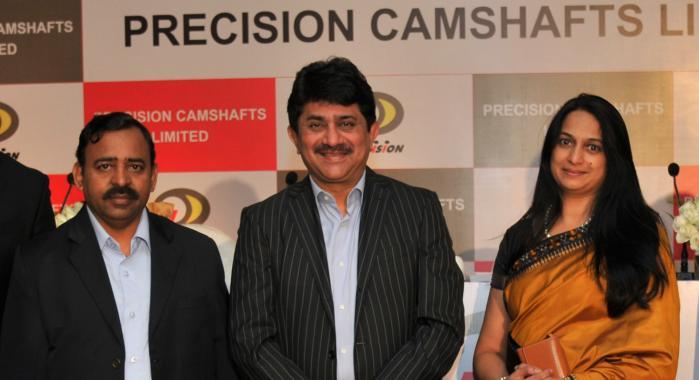
Precision Camshafts IPO will involve a fresh issue of INR240 crore and an OFS of up to 91.5 lakh shares. At the upper end of the price band of INR180-186 per share, Precision Camshafts IPO will garner a total of INR410 crore. The OFS component indicates an increase from the earlier plan of selling 86.4 lakh equity shares through the route, as mentioned in the draft prospectus.
Read Also: Precision Camshafts IPO price range INR180-186, listing by 9 February
Issue Details
| IPO dates | 27-29 January 2016 |
| Price Band | INR180-186 per share |
| Issue Size | INR404.7 – 410 crore |
| Offer for Sale | 91.5 lakh shares |
| Minimum Bid | 80 shares |
Use of IPO funds
Unlike the previous three IPOs which were totally OFS issues, Precision Camshafts IPO will bring some cash to the company. In our analysis, we find it is a vital trait for a company’s growth. Majority of the proceeds of Precision Camshafts IPO will be used to establish a machine shop for ductile iron camshafts at the Solapur plant where the company operates an export oriented unit (EOU) and a domestic unit. The EOU unit consists of four foundries and two machine shops while the domestic unit consists of one foundry and one machine shop. Beyond India, it has two joint ventures with Ningbo Shenglong Powertrain Company Limited in China.
Business growth and export focus is “Good”
Precision Camshafts scores full points on the financial review front. As seen in the accompanying chart, revenue growth has been fantastic in recent years. Apart from a revival in the domestic market, the company was helped by a strong focus on overseas markets and export incentives in recent years played a key role in top line growth. Contribution of exports as a percentage of revenues has been trending higher and increased to a new high of 79% in FY 2015.
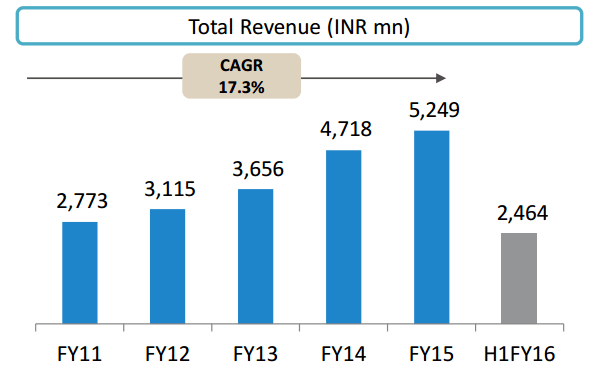
This discussion would be incomplete without talking about the favorable impact currency exchange ratio had on financial performance in recent years. Precision Camshafts is exposed to foreign currency movement (primarily to USD) which have had a positive effect on its finances. These tailwinds are expected to continue in future as well. As an exporter, depreciating rupee is a great positive and there is nothing on the horizon to suggest that Indian rupee is going to reverse its direction. At the same time, the company is benefitting from the softness in commodity prices and foreign currency denominated loans. Primary raw material for Precision Camshafts happens to be pig iron which is sourced from local market. Availability isn’t an issue and this is evident from the fact that its raw material costs increased only 8.4% in FY 2015 while revenue jumped 13.1%.
All in all, these factors helped Precision Camshafts tremendously in reporting exceptional profitability figures. In FY 2015, its margins moved into double digits and have remained there in the six months of FY 2016.
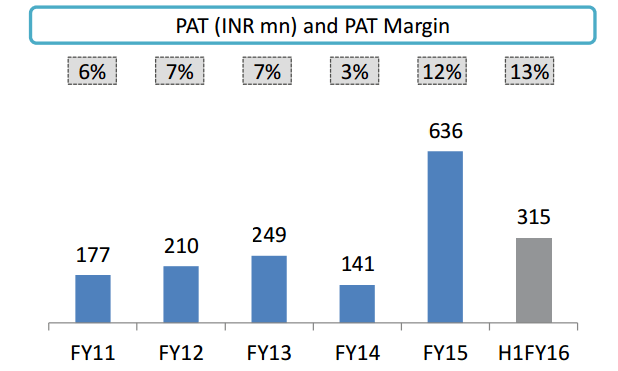
Less scope of margin expansion is “Bad”
Manufacturing camshafts isn’t a very complicated business from technology standpoint and economies of scale often bring in added incentives but it is not a business where technology edge (if there is any) can enhance margins. This is obviously oversimplification but you get the drift. Suppliers of products like camshafts just can’t approach their clients with uncompetitive rates and thus, profitability in such businesses is a function of cost control, more often than not.
The factors behind Precision Camshafts’ strong financial performance are very simple and evident but the same factors also expose the downside. As stated above, there is nothing to dislike in the financial performance of Precision Camshafts. At the same time, the weak foundation of these double-digit margins cannot be ignored. Since the company has no technology edge, its margins are largely dictated by external factors such as competition, exchange rates, export incentives etc. From these high levels, there is very little scope of expanding profit margins any further.
The excessive reliance Precision Camshafts has on its biggest clients is also something to worry about. General Motors and Ford are two of the biggest buyers of camshafts Precision makes. From a high of 43.9% in FY 2014, General Motors’ contribution to Precision Camshafts’ business has come down to nearly 27% in the six months of FY 2016. To compensate this fall, Ford’s contribution has gone up and rather tremendously, from 19.4% in FY 2013 to 30.3% in the latest six month period. Thankfully, Suzuki has come on board as a new client for the company.
“Ugly” payout to promoters
We have been noticing “fun facts’ in corporate filings and have often encountered some interesting stuff, including instances of promoters rewarding themselves exceptionally well. As a result, it was natural for us to put the lens on Precision Camshafts’ promoters who happen to be in key management positions as well.
Yatin Shah is the Chairman and Managing Director who looks after marketing and business development, while Suhasini Shah serves as Executive Director and remains in charge of the legal and compliance department. Both promoters currently own 61.5% stake in Precision Camshafts’ issued share capital. Since these are key designations and responsibilities, we can expect executive remuneration to be competitive. However, Precision Camshafts is more than generous in rewarding its executives cum promoters, in our opinion. Yatin Shah was paid INR10.57 crore in remuneration in FY 2015, in addition to INR5.8 crore in commission. Similarly, Suhasini Shah received INR3.28 crore in remuneration while a commission of INR2.9 crore was also paid during the fiscal year. To say that these figures are quite high would be stating the obvious and to put things in perspective, the company earned all of INR63.6 crore in FY2015.
Paying INR22.55 crore to promoters just because the company is doing well is not a strong logic and it helps to understand that the situation was not so rosy in FY 2014 when Precision Camshafts’ earnings stood at just INR14.1 crore. This shows how quickly things can change on the earnings front and how excessive promoter compensation is something to cringe about. In many ways, it is similar to the practice followed by InterGlobe Aviation promoters to cash out before the IPO – a step that was widely questioned. The IPO went on to do well post listing but the practice remains questionable.
Good enough to invest in?
Precision Camshafts IPO is an interesting play in a booming industry and potentially offers an entry into the growth story set up the hard work of first-generation entrepreneurs. In terms of valuations, the issue is a reasonably priced one at 22.3 times its expected earnings for FY 2016, based on the performance in the first six months. This is in line with the valuation of its competitor Bharat Forge, although Precision Camshafts claims it has no listed peer solely focusing on manufacturing camshafts.
Following last year’s amazing returns in some IPOs, Precision Camshafts IPO may be an excellent opportunity for investors to make smart money in short term. However, the extreme volatility in the secondary market is not exactly supportive of new public offerings.
Overall, we like Precision Camshafts IPO for the growth prospects it offers as well as the sensible pricing. This is a big positive we have analyzed in recent IPOs where unreasonably steep pricing has been the norm. On the flipside, the opportunistic policy of executive compensation leaves a bad taste in mouth and raises question mark on the promoters’ commitment, although this is addressed to a point since both promoters will still be holding majority stake in the company.
In any case, investors need not rush into buy into any specific IPO as they have the luxury of choosing from the long list of upcoming IPOs this year in India.

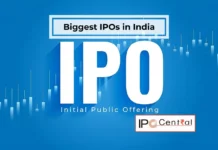









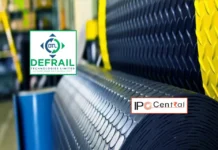
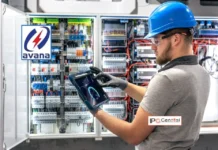























Thanks for your deep analysis of PCL’s profitability, Krishna. But I would slightly differ on the Valuation assessment… I think it’s richly priced. Firstly, the asking P/E is c.26 on fully diluted basis. My DCF evaluation based on 10% to 15% Top-line growth, small 10 bps uptick in operating margin etc yields only 10.5% IRR for equity investors at the offered price range. There is a big ‘Execution Risk’ & Corp Governance issue which the investors are being asked to bear but the reward (IRR) is rather low….
The ‘bad’ & ‘ugly’ cast a ‘nasty’ shadow on the ‘good’. Being a retail investor I’m vulnerable & confused as ever…..
Thanks for your comment Gravitas and great job with DCF analysis. I have been thinking about using more valuation metrics in my analysis but every time come back to the conclusion that stocks driven more by sentiment and less by rationality. I totally agree about the corporate governance part and it is an issue with first-generation entrepreneurs (Power Mech is another name that comes in this category).
However, I would differ on the ‘execution risk’ part. In fact, if there is anything we can say about this company with conviction, it would be in the execution and customer-retention departments.